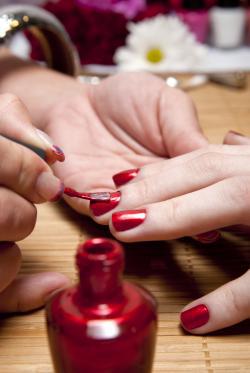Back in 2006, the nascent eco-health movement scored what seemed like a major victory: OPI, Essie and several other brands of nail polish agreed to remove a “toxic trio” of chemicals from their products. This trio consisted of a known carcinogen (formaldehyde) and two reproductive toxins (dibutyl phthalate or DBP and toluene) and had been banned for use in cosmetics by the European Union in 2004. But it wasn’t until young women activists dressed as beauty pageant contestants wearing sashes labeled “Miss Treatment” (a riff on OPI’s punny product names) mounted protests that these polish brands agreed to reformulate the nail polishes and removers sold in almost every nail salon across the United States. “Three-free” became the phrase to look for when you picked your polish color at the nail salon. Manicure fans everywhere breathed a sigh of relief.
Until Tuesday, when a new report by the California EPA revealed that many “three-free” nail products are, in fact, three-full.
State investigators from the California EPA’s Department of Toxic Substances Control randomly sampled 25 brands of polish. They found that 10 of a dozen products claiming to be free of toluene actually contained it; four brands with dangerously high levels. Five of the seven products claiming to be entirely “free of the toxic three” included high levels of one or more of the chemicals. A sample of OPI, the nail polish industry’s leading brand, tested negative for the toxic trio but brands whose products turned out to be mislabeled include smaller outfits (ubiquitous in discount nail salons): Sation, Dare to Wear, Chelsea, Baby’s Breath, New York Summer, Paris, Sunshine, Cacie, Golden Girl, Nail Art, and High Gloss.
“Nail products that contain these chemicals might present serious health risks to those who use them, and to falsely advertise a product as free of these substances is significant public health problem,” says Michael DiBartolomeis, Ph.D., chief of the Safe Cosmetics Program at the California Department of Public Health.
Well, exactly. “How can I choose safer products if I can’t count on the accuracy of information on the bottle?” says Heidi Hoang, a San Francisco nail salon owner and member of the California Healthy Nail Salons Collaborative. “Now that I’m pregnant, I ‘m especially concerned about this problem.”
And she may have good reason to be: Research shows that chemicals like DBP and toluene can act as endocrine disruptors and impact healthy prenatal development. And because girls are now exposed to them and other endocrine disruptors at chronic low levels from so many sources, they may even play a role in the increasing rates of early puberty that Liz Weil explored in her recent New York Times Magazine story.
But how is it possible for so many beauty brands to use potentially harmful chemicals in the first place and then, to label their products “three-free” without actually bothering to remove them? To answer that question, you have to look to Washington D.C., where federal cosmetic safety regulations haven’t changed since 1938.
The Food & Drug Administration is officially charged with monitoring the beauty industry, but it doesn’t have the authority or the manpower to require companies to prove products are safe before they hit store shelves. Even once a problem is discovered, the FDA doesn’t have the power to demand a recall — that’s why Brazilian Blowout is still offered in many hair salons, almost two years after government testing revealed it to contain high levels of formaldehyde (despite a formaldehyde-free label, of course). The brand has been hit with several lawsuits, fined over $5 million and required by the state of California to relabel its products — but the best the FDA can do is send a strongly worded letter.
Thankfully, efforts are finally under way to overhaul the 1938 law: The Cosmetics Safety Enhancement Act of 2012 was introduced and referred to the House Committee on Energy and Commerce by Representative Frank Pallone (D-N.J.) on March 26. And this bill would grant recall authority to the FDA, at long last. But it doesn’t require beauty brands to remove carcinogens and reproductive toxins from their products, nor would they have to fully disclose their ingredient lists.
Why so many loopholes? It’s worth noting that Pallone’s district is home to Johnson & Johnson, one of the biggest beauty-industry players. And yet the beauty industry isn’t satisfied with Pallone’s bill. While Lezlee Weinstein, president and CEO of the industry’s key trade organization, the Personal Care Products Council has acknowledged, “the existing system for regulating our industry is overdue for a makeover,” the PCPC is pushing to have its own panel of industry-funded scientists enshrined by law as the FDA’s own ingredient safety review board.
And last week, negotiations over Pallone’s bill hit an impasse over the question of states’ rights: While Democrats and cosmetic safety advocates are eager to let states amend federal regulations if their own laws are more stringent, Republicans and the beauty industry are having none of it. After all, if the state of California wasn’t so keen to fact-check product labels, we might never have realized this industry wasn’t playing by the rules — or prioritizing women’s and girls’ health — in the first place.
